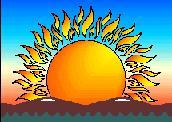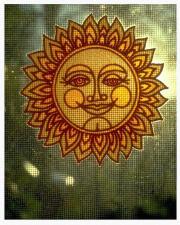 The
Summer Sun Beltaine
1999 The
Summer Sun Beltaine
1999 |
|
|
| Beltaine: The Celtic Calendrical
Hotspot
--Philip Stubbs,
The Anatomie of Abuses
Whatever truth is revealed in the end, Beltaine evidently had a lot to do with driving and heat. The Beltaine ceremony that has the most evidential support in terms of its Celtic and Druidic heritage is the driving of livestock between two  purifying
and invigorating bonfires. While this act seems to be particularly Celtic,
it is important to note that the notion of the purifying and healing effects
of fire has been known as far back and as
far away as the Phoenicians. The Celts, however, added the animal element
possibly to help ensure that their livestock, weakened by winter feed and
quartering, would recover for the new agricultural cycle. This ritual must
have come with its challenges, as anyone who has ever had to control cattle,
sheep or horses around open flames would attest. Passing between the flames
for blessing, the animals would then be escorted into the upper pastures
to begin to feed on the new grasses. How many animals and humans made the
trip slightly singed would be anybody's guess. One thing we can be sure
of, however, is that the ritual must have involved the entire community,
considering its importance to all as well as the necessity for many hands. purifying
and invigorating bonfires. While this act seems to be particularly Celtic,
it is important to note that the notion of the purifying and healing effects
of fire has been known as far back and as
far away as the Phoenicians. The Celts, however, added the animal element
possibly to help ensure that their livestock, weakened by winter feed and
quartering, would recover for the new agricultural cycle. This ritual must
have come with its challenges, as anyone who has ever had to control cattle,
sheep or horses around open flames would attest. Passing between the flames
for blessing, the animals would then be escorted into the upper pastures
to begin to feed on the new grasses. How many animals and humans made the
trip slightly singed would be anybody's guess. One thing we can be sure
of, however, is that the ritual must have involved the entire community,
considering its importance to all as well as the necessity for many hands.
Perhaps in all the heat and sweat and musky animal scents, as well as the convenient cover of darkness and the end of a winter-long abstinence, some of the revelers did what Philip Stubbs decribes above. He goes on to describe the revelers as returning home the following morning with "birch and branches of trees," as well as with that singular branch or trunk that has come to be known as the Maypole, which they would eventually set up and dance around. Again, the idea of a central tree or axis is older than the Celts and may be found in several cultures. It is an obviously phallic symbol; planted in the earth and surrounded with swirling ribbons and twirling bodies it may well have been the centerpiece of a celebration of the pleasures associated with fertility. The Maypole has gone through some rough times, yet still appears each Spring, and not always as a symbolic tree -- the Catholic Paschal, or Christ, Candle adorned with symbols and decorations appears at the Easter Vigil Mass each year, to be lit and dipped thrice into the baptismal waters from which will be born the new members of the faith. There are other traditions associated with May and, possibly, Beltaine which may be found, though less commonly and with less of an obviously Celtic/Druidic connection than the bonfires and Maypole. These include the collection of the first morning dew on May Day, valued for its curative and cosmetic powers; the adorning of homes with tree branches according to the various symbolisms of the variety, called "May birching"; the making of May Dolls which have been associated with the Roman spring goddess Flora as well as the Virgin Mary; May garlands in the shapes of crosses and wheels; and the carving and decoration of May hobby horses. Still, it is the more passionate possibilities of Beltaine that make it so popular as a subject for study as well as a festival to celebrate. In more ways than one, it remains the hotspot of the Celtic calendar. |